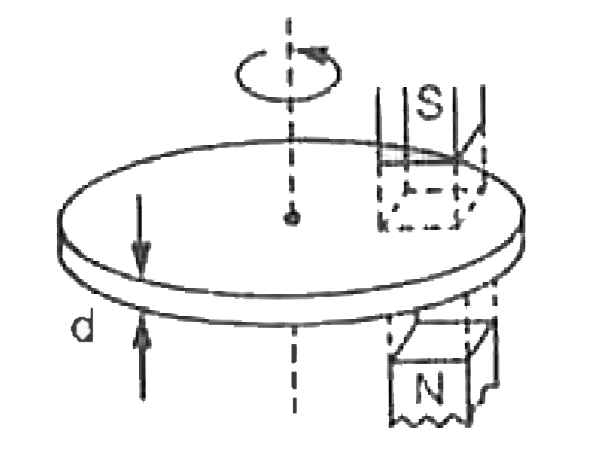An electromagnetic eddy current brak a consists of a disc of conductivity σ and thickness d rotating about axis through its centre between rectangular poles of face area A at a distance from the centre from the centre . Calculate the torque tending to show down the disc .

The correct Answer is:B2Awr2σd
Topper's Solved these Questions
- ELECTROMAGNETIC INDUCTIONBOOK - NN GHOSHCHAPTER - ELECTROMAGNETIC INDUCTIONEXERCISE - EXERICISES
12 Videos
- ELECTRIC FIELD AND POTENIALBOOK - NN GHOSHCHAPTER - ELECTRIC FIELD AND POTENIALEXERCISE - EXERCISE-B
35 Videos
- FUNDAMENTAL OF CURRENT ELECTRICITYBOOK - NN GHOSHCHAPTER - FUNDAMENTAL OF CURRENT ELECTRICITYEXERCISE - Exercises
45 Videos
Similar Questions
A cicular loop of radius 10 cm and 500 turns in turend upside down on a horizontal table in 0.5 s . Calculate the mean emf generated .(Earth's vertical field =0.43×104 tesla)
View SolutionA certain charge Q is divided into two parts q and Q−q, wheich are then separated by a cetain distance. What must q be in terms of Q to maximum the electrostatic repulsion between the two charges?
View SolutionA wire carries a constant current of 10A. How many coulombs and how many charge carriers pass a cross-rection of the wire in 20 seconds? (charge of electron = 1.6×10−19C
View SolutionA uniform disc is rotating at a constant speed in a vertical plane about a fixed horizontal axis, passing through the centre of the disc. A piece of disc from its rim detaches itself from the disc at the instant when it is, on the same horizontal with the centre of the disc and moving upwards. lien about the fixed axis, the angular speed of the
View SolutionA circular disc is rotating in horizontal plane about vertical axis passing through its centre without friction with a person standing on the disc at its edge. If the person gently walks to centre of disc then its angular velocity
View SolutionFrom a uniform circular disc of diameter D, a circular disc or hole of diameter D/6 and having its centre at a distance of D/4 from the centre of the disc is scopped out. Determine the centre of mass of the remaining portion.
View SolutionA uniform disc is rotating at a constantt speed in a vertical plane about a fixed horizontal axis passing through the centre of the disc. A piece of the disc from its rim detaches itself from the disc at the instant when it is at horizontal level with the centre of the disc and moving upward. Then about the fixed axis, the angular speed of the
View SolutionA disc of radius R rotates with constant angular velocity ω about its own axis. Surface charge density of this disc varies as σ=αr2, where r is the distance from the centre of disc. Determine the magnetic field intensity at the centre of disc.
View SolutionMoment of inertia of a disc about an axis parallel to diameter and at a distance x from the centre of the disc is same as the moment of inertia of the disc about its centre axis. The radius of disc is R . The value of x is
View SolutionA coin placed on a horizontal rotating disc, with its centre at 10 cm from the centre of the disc, is about to slip off when the disc performs 60 rpm. Find the coefficient of friction between the coin and the disc.
View SolutionRadius of gyration of disc rotating about an axis perpendicular to its plane passing through through its centre is (If R is the radius of disc)
View SolutionA circular disc rotates at 60 rpm about an axis passing through its centre. A coin of 18 g is placed at a distance of 8 cm from the centre of the disc. Calculate the centrifugal force on the coin.
View SolutionA disc of radius 10 cm is rolling on a horizontal surface. The velocity of its centre is 4ms−1 and angular velocity of rotation of the disc is 50 rads−1. What is the distance (in cm) of instantaneous axis of rotation from the centre of the disc ?
View SolutionA horizontal disc is rotating about a vertical axis passing through its centre. If an insect moves from centre to rim then the angular momentum of the system
View SolutionA horizontal disc is rotating about a vertical axis passing through its centre. If an insect moves from centre to rim then the angular momentum of the system
View Solution

